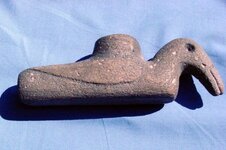dg39
Bronze Member
- Mar 30, 2006
- 1,869
- 37
- Detector(s) used
- Ace 250--White's 6000 DI Pro
- Primary Interest:
- All Treasure Hunting
Spoke with Lar Hothem by Email yesterday and today. He very kindly anwsered my questions on the Ceremonial pipe. Thought those of you who commented on my last posting would like to know also. And many thanks to the person who suggested getting in touch with him! 
 ,,,,Here is his response:
,,,,Here is his response:
Thanks for your email and the two pictures. From these, it appears the artifact is what is known as a Southern Great Pipe. These are typically quite large, in the effigy of some kind of bird, raised bowl on the back, stem opening in the under-tail region, and material a dark steatite or soapstone. The time period is known to be Early Woodland into Mississippian times, or somewhat after 1000 BC to AD 1600 or so, though I think the last general date is uncertain. These are found throughout much of the South and as far north as Ohio, though they are rare in this state. They are not at all common, and due to size many have been damaged by farming and construction equipment. Hope this helps. If you like, I'll be glad to send a free book catalog that has some titles on Indian pipes.
Best,
Lar Hothem

 ,,,,Here is his response:
,,,,Here is his response:Thanks for your email and the two pictures. From these, it appears the artifact is what is known as a Southern Great Pipe. These are typically quite large, in the effigy of some kind of bird, raised bowl on the back, stem opening in the under-tail region, and material a dark steatite or soapstone. The time period is known to be Early Woodland into Mississippian times, or somewhat after 1000 BC to AD 1600 or so, though I think the last general date is uncertain. These are found throughout much of the South and as far north as Ohio, though they are rare in this state. They are not at all common, and due to size many have been damaged by farming and construction equipment. Hope this helps. If you like, I'll be glad to send a free book catalog that has some titles on Indian pipes.
Best,
Lar Hothem




 ?
? 
 I think you should submit that one "Best Finds" W.E.T! Awsome!
I think you should submit that one "Best Finds" W.E.T! Awsome!


